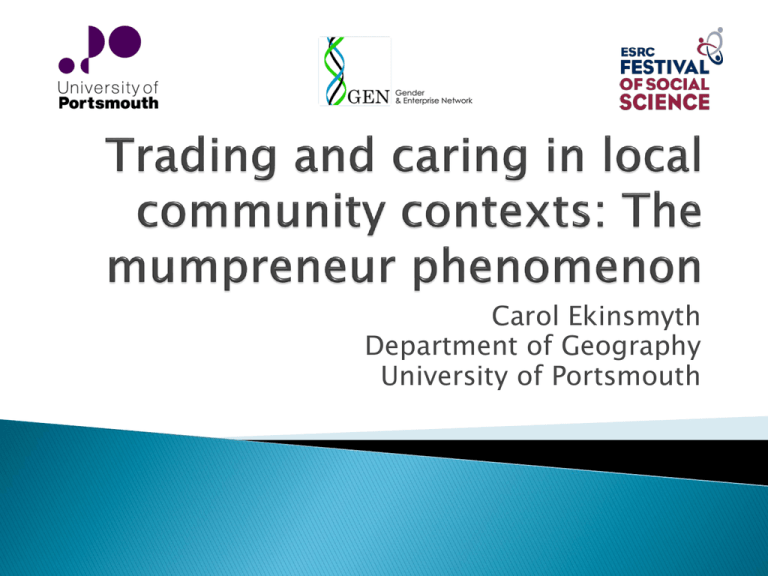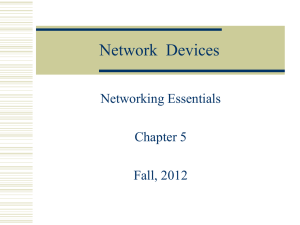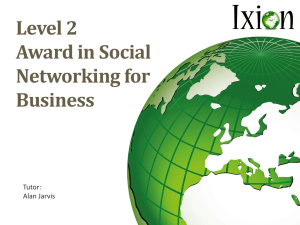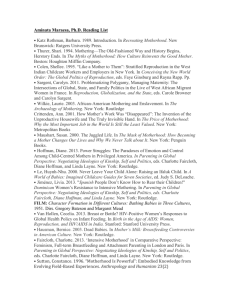Trading and caring in local community contexts
advertisement

Carol Ekinsmyth Department of Geography University of Portsmouth What is mumpreneurship? What is distinctive about mumpreneurs? What is their role/impact in neighbourhoods and communities? What might we learn from the phenomenon? Does she represent social change or the cementing of current gender inequality? Oxford English Dictionary Online (2011) defines it less specifically than I do Key criteria: Mothers who configure business around their motherhood role rather than juggling the two (Ekinsmyth 2011, 2013). ◦ Motherhood comes first, business second ◦ Businesses can grow out of mothering experiences ◦ Businesses can be positioned in the parenting sector or even mumpreneur sector – but this isn’t necessary. The definition is about motivation and practice, not sector. This definition: 1. Does not exclude dads who have done similar (where they are the primary-carer) 2. Does not limit business location to home 3. Does not include mothers who run businesses where these businesses are not configured to work around the work of motherhood 4. Is not limited to parent and children-related products “… I mean I get to structure my days as I want to … and the child care I want to and I think I am in a unique position in that all my clients are mums they all understand the way that I have to work… … I think in general, I think it just allows me to earn some money, I mean not masses, but enough to help pay the bills and that kind of thing.” “I want to make a difference and how can I do it given my circumstances called, I have a child and I’m about to have another one, less time, how can I be more effective? Um, how can I make money?” (Liz, Dance and Music Therapy) “…a form of entrepreneurship driven largely by the desire to achieve ‘work-life harmony’ through an identity orientation that blurs the boundary between the roles of ‘mother’ and ‘businesswomen’” (Ekinsmyth, 2011,104) Ways of doing business Combining business and motherhood as a business strength Rejection of ‘entrepreneur’ label Rejection of ‘textbook’ business practice Rejection of traditional ‘entrepreneurial values’ of profit and slickness Giving something back Keeping it personal Helping people Professional background Entrepreneurship from the mundane spaces and places of motherhood (Ekinsmyth 2011) – extracting value from everyday life Narrative from a Mumpreneur business website: “Sara has 3 children and is working on keeping all her balls in the air! On any given day she can be found juggling school runs and business meetings, swimming lessons and networking, parents evenings and nights out! She is making progress in serving up edible dinners and always enjoys her weekends!” Research shows that for professional women, their lives diverge from those of men at the point at which they become mothers Mothers’ working biographies commonly differ from those of women without children and men (Leahy and Doughney, 2006) Some mothers start up businesses as a way to manage/blur the boundaries between motherhood and re-numerated work. Mumpreneurs, in common with the middle classes, have a role-orientation towards ‘intensive motherhood’ (Hays 1996, Ekinsmyth 2011, Duberly and Carrigan 2012) Long hours culture: professional work incompatible with intensive parenting. Mumpreneurs creatively seek ways of building viable businesses under these circumstances Appears to have emerged simultaneously in the USA and the UK (mid 2000’s) – media promoted Major players – a handful of innovative women who saw the potential to build support/networking businesses around the phenomenon A bottom-up movement – fills gap left by policy/funding shortfalls “I see it as a movement – it’s gathering pace – lots of women looking for different ways to make their lives work. We are a group and there is a hierarchy.” (Winona, Founder of a UK-Internetbased, family-orientated gite-booking agency, Interviewee, 2010). Much confusion over what term means My analysis of 4 internet discussion forums revealed heated debate and diametrically opposed views including a feminized entrepreneurial identity, a feminist statement, a potential ghetto, smug, patronising and sexist (Ekinsmyth 2013). There is agreement that we need to dismantle the stereotypes of who can be an entrepreneur. There is disagreement over how this can be achieved. Is at a specific stage in her life-cycle and has made a specific choice/or is positioned in a particular place with respect to motherhood and work. This means that she does business under certain (common) conditions These conditions mark her as someone who is doing business differently and they are key to understanding the kind of business she builds. Time-space constraints (Normally) needs to make business work in a domestic environment (home, neighbourhood) Local neighbourhood thus can be an enabler or disabler Heavy use of Internet Time-space shifting Dual or blurred identity Studies have demonstrated time and again that women’s and men’s time-space vary Mothers report that the co-location of work in the spatial realm of family life is the most common motivation for building businesses around the work of motherhood “I want to be present for my children.” … a business owner who has configured a business around the time-space routines of motherhood, where “motherhood” is understood to be the primary carer role in social reproduction (Ekinsmyth 2013, IJEBR). Working around family commitment s Use of local, neighbourho od social contacts Time-space routines of motherhood Networking in neighbourho od spaces Limited daily spatial range Neighbourho od-based daily activities “…despite ICT saturation…, most of us spend much of each day orchestrating continual movement in relation to others” (Jarvis,2005) Daily life is enabled and constrained in space-time by the availability of jobs, services, utilities, institutions, housing, transport and members of our social networks Places vary New motherhood, new ways of experiencing spaces and places. How to make this new spatial boundedness work for business? New parents are especially positioned for innovation (Stayeart and Katz, 2004) – they are experiencing new problems for the first time. They are a resource worth supporting. “I can run a global company but I can’t get to Kent” Neighbourhoods Community spaces Family homes Virtual spaces Business spaces How can we make neighbourhoods more business-friendly? Mumpreneurs frequently draw on their local social contacts for stimulation, networking, recruitment and ideas. This can be both an opportunity and a constraint. A mumpreneur’s local social networks are the most significant and/or universal aspects of neighbourhood that root a business in place. “I don’t know what I’d do without those mums at the school gates because if I am ever late from work or if I’ve got a meeting I just ring them and say look can anyone help – and they help. They keep me sane as well.” “I’ve worked really hard at making that community” Natalie, mumpreneur networking franchise, 2 kids, 8 and 5. If lucky Domestic neighbourhoods abound with (nonbusiness) activities and offer a rich and diverse complement of human capital – indeed a more diverse mix than any workplace offers Significant business ties coming from the non-business realm. Mumpreneurs frequently draw on their local social contacts for stimulation, networking, recruitment and ideas. This can be both an opportunity and a constraint (overembeddedness – “lock-in”?) Parent-based networks can be vital for the recruitment of like-embedded people: As employees As outsourcees As clients “First I had Kath, she set up a group in Bafton, [How did you meet her?] She was a Mum, she’s got Isobel, the same age as Emily, they were at nursery together, she had been a teacher, and there was the two of us for 18 months, then Sian got involved [another personal friend], then Kath moved, Sian went back to work and then I got Emma [a friend through respondent’s choir] who is fantastic, she was a nurse but had 4 children and she has been with me for 3 years now….” (Sharon, children’s education sector). Community space is vital as a creative space – a space where business is born This networking is social, not business-oriented Uses latent human capital for business “We were three mums with a lot of children between us and we constantly had a problem with nits. We had nothing to do with nits, one of us was a manager of a body shop branch, my daughter’s best friend’s mother did aroma-therapy and massage and she came up with a couple of concoctions …. And one day she came up something that really did get on top of them … and my daughter said, I think this has worked, you should think about making this and selling this to the other mums. We had a laugh and then thought about it and …………. We started the business, it literally was kitchen sink stuff ….. we all put in a tiny bit of money for some bottles and we thought we would market it through word-of-mouth….” (Alice, headlice treatments) Neighbourhoods vary in their potential as the spatial context for business. ICTs are able to negate some of this variability For some industries however (creative), face-to-face networking, group stimulation and buzz are vital (and often lacking in domestic neighbourhoods) “I think it’s just a different lifestyle, geographically I am just in the wrong place and time-wise, I suppose I still require a level of commitment to networking and socializing that I just don’t have at the moment” (Jane, Music Therapy and Composer) Loose, repetitive ties are comforting, ‘homely’, ‘sense of community’, not feeling isolated These contribute to the intangibles (– the affective dimensions of ‘place’ (Tuan 1977)). “I chose the room at the front of the house so that I could watch the comings and goings of my neighbours and not feel too isolated” Anne, Son aged 7, artist & designer Often spread out over a much wider geographical field (can be global) Often ICT enabled Business networking (e.g. belonging to ‘mumpreneur’ business networking groups, craft groups and associations etc) We miss a good deal of significant networking if we only concentrate on this form of networking. Importantly, we can miss the neighbourhoodbased networking. Non-economic networking is vital to mumpreneur businesses (networking embedded in the social rather than the economic realm) Business to business ties are far less dependent on the local than business enhancing social ties Neighbourhood capital can be vital This capital can and does fuel business It varies geographically What are the effects of this activity on neighbourhoods? If mumpreneurship is an incubation phase, what happens to neighbourhood ties when business practice becomes more conventional? How is mumpreneurship a middle-class phenomenon and what are its outcomes in terms of social division? Low-cost, lowrisk start-up. Working in family spaces (home) Use of ICT’s and social media * Finance and economic security Appears to be a middle-class phenomenon * Space in the home Why? * Social and educational capital * Intensive motherhood *Role models “Several studies indicate that, during the start-up process, family plays an important role in the mobilization of financial resources…, the provision of human resources…, and physical resources in the form of space in the family household.” (Aldrich and Cliff 2003, 577). Many others do business under constraints – it is perhaps time for enterprise policy to recognize (better) key groups who might be identified through shared constraints. Mumpreneurs have sought recognition/visibility and built a support infrastructure for themselves. The domestic neighbourhood and its social networks can be an important source of and resource for business We should consider forms of spatial policy that might be instigated (for example, investing in neighbourhood working hubs with integrated ‘drop off’ crèche facilities). Spaces for networking and unintended learning are vital. The current fashion for co-working spaces bears this wisdom out. Positive interventions might help to build local cultures of (female) entrepreneurship. Does it benefit the women and their families? Does mumpreneurship benefit communities How can mumpreneurship spread its benefits further – beyond the (white?) middle classes? What do we need in communities to encourage these processes? What policy interventions are needed? What form should they take? Mumpreneurship is time-limited, just as children are As a practice, it is probably best thought of as a transition stage – (though I met someone this year who said she had been a mumpreneur for 25 years) It is useful for encouraging talent and creativity, building business and building vibrant communities It could also be useful in building resilient communities, especially if infrastructure can be encouraged to make visible, share and spread the activity 1. Should we be focussing policy intervention on individuals or neighbourhoods/communities? ◦ How might we build resilient neighbourhoods/communities? 2. Are other women disadvantaged by the mumpreneur term? How can this be changed? Dr. Carol Ekinsmyth, ESRC Festival of Science, Manchester Metropolitan University, November 4th, 2014 Ekinsmyth, C., (2013), “Mothers’ business, work/life and the politics of ‘mumpreneurship’”, Gender, Place and Culture, (ahead of print), 1-19. Ekinsmyth, Carol, (2013), “Managing the business of everyday life: The roles of space and place in ‘mumpreneurship’”, International Journal of Entrepreneurial Behaviour and Research, 19, 5, 5-5. Ekinsmyth, C., (2012), "Family friendly entrepreneurship: New business formation in family spaces”, Urbani Izziv 23 (s1): S115-S125. DOI: 10.5379/urbani-izziv-en-2012-23-supplement-1-011. Ekinsmyth, C., (2011), "Challenging the boundaries of entrepreneurship: The spatialities and practices of UK ‘mumpreneurs’”, Geoforum, Vol. 42, pp.104-114.




